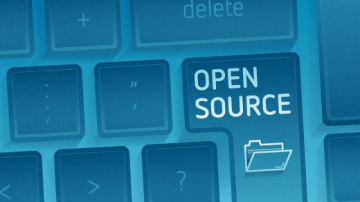In my previous article, I explained the benefits of setting your professional goals in the open—collaboratively and transparently, so others could enrich the process. And earlier in the year, I provided my perspective on performing your professional self-assessments the same way. Now I'd like to offer my preferred process for making all this work.
Approaching transparent and collaborative goal setting
The Open Decision Framework provides a useful process for setting goals transparently and collaboratively. Applying it to goal setting means identifying people that will be impacted by your goals or those who could help you make them better. Invite these people to hear you articulate your goals, and allow them to share their feedback on those goals with you. At the heart of the Open Decision Framework is constant communication: The framework guides you on what things to consider communicating, who to communicate them to, and when to communicate them.
Whatever goal setting methodology you choose (be it SMART, OKRs, or something else), approach the process as its own project in a transparent and collaborative way. In other words, treat the goal setting process as its own project, just like you would the work toward the goals themselves.
Start with where you are
Before stating your wild goals for the future, first build an understanding of where you are now. This way you'll be able to chart a clear path from here to your ideal future state—that is, once you've identified your goals.
First, begin building that understanding. Look around you and see what information and resources you already have at your disposal: Corporate vision and mission statements, departmental goals and objectives, team SWOT analysis, your own development plan—these are all good examples of existing internal sources of information that can help you build your understanding of your current working landscape and align with others in the business.
Next, add more depth to that landscape. Look for current topics and trends inside the organization. Look externally to your customers' focus, then examine industry trends. This can be as simple as taking note of what senior leaders in your organization are talking about, what your customers are posting on their websites, and what industry news feeds are promoting to get a greater sense of what's happening around you.
This added layer of information can help you start seeing ways you, your team, or your department could set goals that contribute to serving your customers and achieving your company's vision. This creates alignment.
Information that feeds into your understanding of the current landscape doesn't just have to come in the form of artifacts, however. Think about who you might speak with to add to the written information you have: managers, peers, direct reports, customers. In every conversation is an an opportunity to spend a couple of minutes building a greater understanding of the environment you work in.
Articulate where you want to be
Now that you've started assessing some areas in which you, your team, or your department could invest to begin solving a customer problem and align to the company's vision, you can identify more specifically who you are serving and what the business need is by creating some goals to guide that investment.
The Open Decision Framework poses some useful questions to identify stakeholders and alignment to the business. For example:
- Whose problem am I trying to solve?
- What are the people I serve looking for from me?
- What's the business need?
- Who will I need or want help from?
- Who could be impacted from my work?
- Who has set a similar goal before?
- Who is likely to disagree, dissent, reject, or opt out?
- Who else may care?
By answering these types of questions you'll be able to start articulating your goals as objectives that solve a business need for a stakeholder in alignment with the company's vision. This articulation is what you can take to stakeholders to ask for their feedback; the act of doing this underscores your transparent and collaborative engagement.
Engage with your stakeholders
Now you have an understanding of where you are and you can articulate your goals to your stakeholders. Great! Now it's time to meet with them and gather their feedback and input.
You could use your own venues for this. Remember that as a manager of a team or a director of multiple teams, The Open Organization says, "you have the power to create venues for bringing people together, and you have the power to set the agenda."
In that meeting, share your problem statement, goals, and intended approach to help your stakeholders understand your thinking behind the goal setting process. Then leverage this opportunity to gather rich feedback by going beyond the generic, "Any questions?" and asking specific questions to elicit more useful feedback.
- Where do you disagree with our definition of the problem statement?
- From your experience, what gaps do you see in our approach?
- Given how you see our team's strengths, where could we be bolder in our action?
- Who else do you think could help us improve our goals?
Getting started with this could be as simple as inviting your stakeholders to one of your regularly scheduled meetings. Or your could get more creative: host a panel discussion, give a series of lightning talks, or establish some other platform altogether. The point is that it doesn't have to be difficult and it doesn't have to be boring—just keep your focus on the end game, share your goals, and get some feedback.
If you can't get the people to come to you, then go to where the people are. Use existing venues such as asking for a few minutes to present your goals in another team's meeting. Look to the virtual world; The Open Organization reminds us that, "By using technology as an ally, you can reach out to far more people in the organization than can fit in a meeting room." Look for existing communications vehicles that you could hitch your wagon to, such as newsletters, intranet landing pages, or local and regional office communications.
Of course, whatever means you use to engage with your stakeholders, as The Open Organization tells us, "When you do, be open, honest, and frank." Acknowledging that you don't have all the information is a great way to allow others to step in and help fill the gaps.
Remain transparent
Transparent and collaborative goal setting is not a one time activity. Just as glass needs regular cleaning to avoid becoming opaque, your goals and collaboration with stakeholders need regular review. Keeping stakeholders informed about progress in achieving your goals is as important as informing them about the goal setting process in the first place. Your biggest obstacle to achieving this is your willingness to create the time and space for it to happen. There are two ways to get around this problem, and you can use them both:
- Go guerrilla. As circumstances change with the passage of time and people move in, out, and around the organization use these moments as opportunities to reconnect with your stakeholders to update them on progress, celebrate successes, and solicit feedback.
- Get programmatic. Dedicate a segment of your regular All Hands meeting to reconnect your team and stakeholders to your goals, progress, and remind them how their roles connect to the company's vision.
Meetings and events are ephemeral, so make sure you generate artifacts from them that others can consume asynchronously. Slide decks, video recordings, podcasts, and blogs are all good examples of content you can extract from a meeting and make available for others to consume when they have the time. Creating and promoting these artifacts are the perfect tasks for anyone in your team looking to develop their communication skills.
Ongoing communication is the key to being an open organization. By communicating regularly you are establishing a habit that builds an open culture: "Setting goals transparently and collaboratively? Oh that's just how we do it here."







Comments are closed.